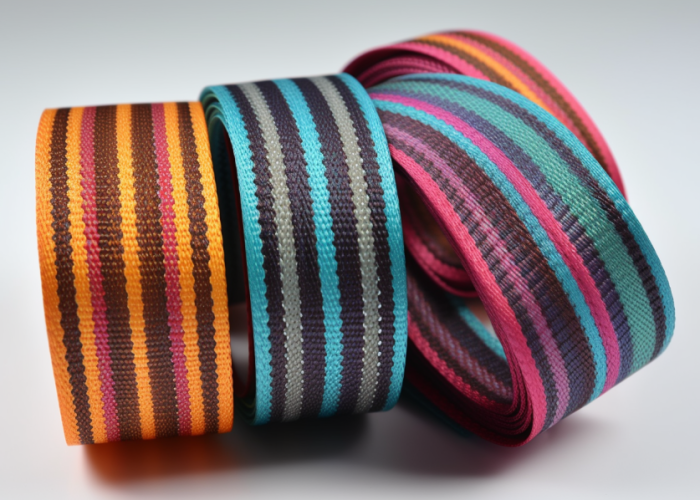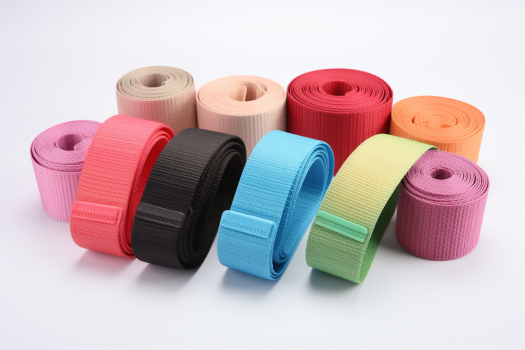Selecting durable webbing materials directly impacts product performance, safety margins, and long-term cost effectiveness. Understanding material durability becomes essential when designing products requiring structural integrity across diverse environmental conditions.
Nylon webbing demonstrates with 15-20 year life spans indoors and 5-8 years outdoors, offering 6,000-12,000 pound breaking strengths while maintaining 85-90% original strength after extended environmental exposure. Surface treatments can extend outdoor performance by 100-150%, and proper material selection with manufacturing optimization significantly enhances application-specific durability.
Explore key durability factors, compare performance data, and get expert tips to optimize material and specs for high performance and cost efficiency.


Webbing manufacturing expert with 15+ years of experience helping product developers build high-performance straps for industrial, medical, and outdoor use.
Nylon webbing achieves superior abrasion resistance through its polyamide molecular structure and fiber construction, generally exhibiting higher abrasion resistance than polyester webbing with performance varying based on material specifications and testing methods. Commercial-grade nylon webbing demonstrates tensile strengths ranging from 6,000-14,000 pounds for 2-inch widths depending on weave type and manufacturer, while surface coatings can significantly enhance abrasion resistance with improvements depending on coating type and application.
Key Abrasion Resistance Factors:
The polyamide molecular structure creates natural resilience against surface friction while preventing localized failure points common in less durable materials. This proves particularly valuable for applications involving pulleys, edges, or rough contact surfaces.
Surface coatings significantly enhance performance: PVC coatings provide substantial improvements but add stiffness (best for cargo tie-downs), while polyurethane treatments offer superior performance in climbing gear and marine applications where flexibility remains essential.
Tubular construction enhances abrasion performance through double-layered design, offering increased protection compared to flat webbing. Specialty weave patterns can be customized to match directional wear forces, providing targeted performance while maintaining cost efficiency for dynamic loads.
Nylon webbing offers the highest overall durability among synthetic options, with superior abrasion resistance and 10-15 year indoor lifespans under real-world conditions, while polyester provides better UV resistance for outdoor applications. Material selection depends on specific application requirements, with nylon excelling in dynamic loading and polyester in outdoor exposure, while polypropylene offers cost-effective solutions for light-duty applications.
Material Comparison Overview:
Nylon excels in shock absorption with 20-30% elongation at break, ideal for vehicle recovery, safety harnesses, and lifting applications. Its excellent abrasion resistance and chemical compatibility make it suitable for automotive and industrial environments.
Polyester provides optimal choice for permanent outdoor installations due to exceptional UV stability and minimal moisture absorption. With only 10-15% elongation, it maintains dimensional stability for architectural applications and marine environments.
Selection should prioritize application-specific requirements: nylon for indoor industrial use, polyester for outdoor applications, and polypropylene for cost-sensitive light-duty projects.
Material Breaking Strength Abrasion Resistance UV Resistance Heat Resistance Chemical Resistance
Nylon 6,000–14,000 lbs Excellent Good Good (to 180°F) Excellent
Polyester 5,000–10,000 lbs Good Excellent Excellent Good
PP (Polypropylene) 3,000–6,000 lbs Fair Fair Poor Excellent
Weather exposure reduces nylon webbing durability significantly, with UV radiation causing 20-30% strength loss after 2 years of direct sunlight, while heat above 180°F and moisture absorption of 3-4% can reduce performance by 10-15%. Protective treatments and proper material selection can mitigate weather impacts, extending outdoor service life from 3-5 years untreated to 5-8 years with UV protection.
Weather Impact Factors:
UV radiation poses the greatest threat through photodegradation. UV-stabilized treatments reduce degradation from 20-30% to 5-10% over two years, making protective treatments cost-effective for outdoor applications.
Temperature effects are predictable: full strength maintained to 180°F, with gradual reduction beyond. Cold weather improves tensile strength but reduces flexibility. Thermal cycling accelerates fatigue failure, particularly in braided or elastic weaves compared to flat woven types.
Moisture absorption of 3-4% temporarily reduces breaking strength by 10-15% but reverses upon drying. Saltwater environments require regular freshwater rinsing to prevent salt crystal abrasion, but don’t inherently damage the material.

Nylon webbing lasts 10-15 years in real-world indoor applications and 5-8 years outdoors with proper maintenance, while heavy-duty industrial use typically provides 4-6 years of service life. Ideal storage conditions away from heat, UV, and chemicals can extend indoor lifespan to 15-20 years, but typical indoor environments with some environmental exposure reduce this to the 10-15 year range.
Lifespan by Application:
Indoor applications achieve 10-15 years in typical environments, reaching 15-20 years only under ideal climate-controlled conditions with minimal UV exposure and stable temperatures.
Outdoor applications benefit significantly from UV treatments: treated webbing achieves 8-12 years versus 3-5 years untreated. Treatment costs typically pay for themselves through extended service life.
Heavy-duty industrial use provides 4-6 years under normal conditions, with load cycling frequency directly impacting fatigue life. Marine environments achieve 3-7 years depending on maintenance intensity, requiring regular freshwater rinsing and proper storage.
Nylon webbing durability improves significantly through surface treatments, proper storage practices, and manufacturing optimizations including heat setting and specialized weave patterns. Protective coatings can extend outdoor service life by 100-150%, while proper maintenance and load management maximize operational lifespan across all applications.
Durability Enhancement Methods:
Surface coatings provide the most effective enhancement: PVC for non-flexing applications like cargo straps, polyurethane for flexible applications requiring chemical resistance and dynamic loading capability.
Heat setting improves dimensional stability by 15-25%, particularly beneficial for precision applications requiring consistent length control. Manufacturing customization through tubular construction and specialty weave patterns optimizes performance for specific wear forces.
Proper storage in climate-controlled conditions eliminates UV and temperature cycling damage. Load management within working limits prevents premature fatigue, with thermal cycling considerations recognizing that braided weaves experience fatigue sooner than flat woven types.
Replace nylon webbing when visual inspection reveals cuts, burns, or excessive wear, when strength testing shows 20% reduction from original capacity, or according to industry-specific schedules ranging from 2-4 years for military applications to 8-10 years for automotive tie-downs. Safety-critical applications require proactive replacement at 70% of expected service life, while regular inspection every 6 months enables early detection of degradation.
Replacement Indicators:
Visual inspection identifies immediate replacement needs: cuts deeper than 10% thickness, burns causing fiber melting, or fraying affecting more than 5% width. Discoloration indicates material degradation compromising long-term performance.
Strength testing every 2-3 years for critical applications determines replacement when 20% strength reduction occurs. Industry schedules vary: military (2-4 years), aerospace (5-7 years), automotive (8-10 years) based on risk tolerance and operational requirements.
Safety-critical applications benefit from proactive replacement at 70% expected service life, providing safety margins while maintaining cost-effectiveness for lifting, safety harnesses, and structural rigging applications.
Choose a webbing manufacturer based on their engineering consultation capabilities, custom testing and prototyping services, quality certifications, and technical partnership approach that optimizes your design rather than simply fulfilling orders. Look for manufacturers offering design-phase collaboration, load calculation support, and comprehensive quality assurance processes that ensure consistent performance and regulatory compliance.
Key Selection Criteria:
Engineering consultation capabilities distinguish manufacturing partners from suppliers. Look for manufacturers offering design-phase collaboration, load calculations, and application-specific expertise rather than just order processing.
Custom testing and prototyping services enable design validation before production commitment. In-house testing capabilities verify performance claims and provide documentation for regulatory compliance. ISO 9001 certification demonstrates quality management systems, while specialized certifications indicate industry expertise.
Technical partnership focuses on collaborative problem-solving, contributing manufacturing knowledge to improve design concepts and identify optimization opportunities. Early collaboration often results in superior products through optimized material selection and manufacturing processes.
Nylon webbing delivers exceptional durability through superior abrasion resistance, 10-15 year lifespans, and customizable enhancements including protective coatings and specialized construction methods. Proper material selection, manufacturing optimization, and maintenance protocols maximize performance while managing costs across diverse industrial applications. Contact us to explore manufacturing solutions tailored to your nylon webbing requirements.
Yes, nylon webbing can meet OSHA fall protection requirements, military specifications (MIL-W-4088), and marine standards when properly manufactured and certified. ISO 10993 biocompatibility certification is available for medical applications requiring specialized compliance.
Thicker webbing provides proportionally higher breaking strength and abrasion resistance. 1-inch thick nylon typically offers 3,000-6,000 pounds breaking strength, while 2-inch provides 6,000-14,000 pounds, with enhanced resistance to cuts and environmental degradation.
Choose nylon for dynamic loading applications like vehicle recovery, safety harnesses, and shock absorption where elasticity is beneficial. Select polyester for outdoor architectural installations, awnings, and marine rigging where dimensional stability and UV resistance are priorities.
Standard nylon webbing typically ships within 2-4 weeks with 500-yard minimums. Custom specifications including special coatings, colors, or weave patterns require 6-8 weeks with minimums varying from 1,000-5,000 yards depending on customization complexity.
UV-treated nylon typically costs 15-25% more than standard grades, while PVC-coated versions add 20-35% to base pricing. Polyurethane coatings represent 30-50% premium but often justify costs through doubled service life in harsh environments.
Industry standards typically recommend 5:1 safety factors for critical applications and 3:1 for general use. For 2-inch nylon webbing with 8,000-pound breaking strength, working loads would be 1,600 pounds (5:1) or 2,667 pounds (3:1) respectively.